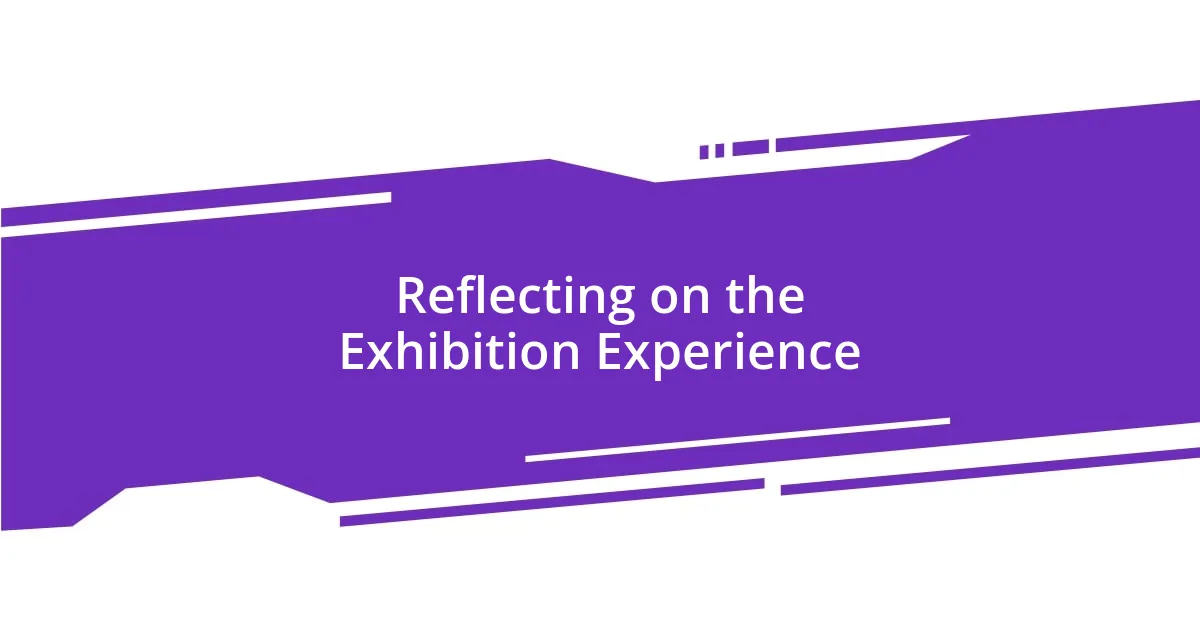Key takeaways:
- Curating is about weaving a narrative that connects art with the audience’s experience.
- Diversity in artist selection and artwork enhances engagement and invites varied perspectives.
- Thoughtful space design impacts how visitors interact with art, influencing their emotional experience.
- Promotion through social media and storytelling deepens audience connection and boosts exhibition visibility.

Introduction to Art Exhibition Curating
Curating an art exhibition is an intricate dance of creativity and organization that I truly find exhilarating. I remember the first time I stepped into a gallery and felt the palpable energy of the artwork around me. It made me wonder: how do curators decide which pieces to showcase together?
In my experience, the essence of curating lies not just in selecting art, but in weaving a narrative that resonates with the audience. I once had the chance to curate a collection that highlighted emerging artists, and hearing visitors share their thoughts on the pieces was incredibly rewarding. It became clear to me that every choice—every color, every theme—plays a crucial role in shaping the viewer’s journey.
Navigating the delicate balance between artistic vision and audience engagement can feel daunting. Have you ever visited an exhibition that moved you in unexpected ways? When I designed an exhibition around shared human experiences, the discussions it sparked reminded me just how powerful art can be in connecting us all.

Selecting Artists and Artwork
Selecting artists and artwork involves a thoughtful process that reflects both personal taste and the overarching theme of the exhibition. I remember sifting through countless portfolios, each one telling a compelling story in its own right. Choosing an artist isn’t just about their technical skill; it’s about how their work can resonate with the exhibition’s narrative.
In my experience, consideration of diversity in both artists and their artworks is essential. When I included a mix of mediums spanning photography, painting, and sculpture in one of my previous exhibitions, it created a rich tapestry that invited viewers to engage from multiple perspectives. It’s fascinating how different forms of expression can communicate similar messages, drawing people in and provoking thought.
To streamline the selection process, I often create a comparison table to weigh different attributes of artists and their works. It helps clarify the decision-making process and ensures a balanced representation. Here’s a simplified representation of how I might compare potential artists and their artworks:
| Artist | Artwork Description |
|---|---|
| Artist A | Colorful abstract piece exploring urban life |
| Artist B | Serene landscape photography capturing nature’s essence |
| Artist C | Mixed media work addressing social issues |
This method has proven invaluable in honing in on the best candidates whose works align and elevate the exhibition’s theme.

Designing the Exhibition Space
Designing an exhibition space is an art form in itself, one that requires a deep understanding of the audience’s experience. When I first conceptualized a layout for an exhibition on resilience, I felt a rush of excitement as I envisioned how each piece could interact with one another. I arranged the artworks in a way that led visitors through a journey—starting from struggles to ultimately celebrating triumphs. Walking through that space felt like stepping into a narrative, each corner revealing something new that invited reflection.
There are several considerations that guide my design choices for exhibition spaces:
- Flow: I think about how visitors will naturally move through the space, ensuring their journey feels intuitive.
- Light: Experimenting with lighting can dramatically change the ambience and perception of the artworks.
- Proximity: Placing related pieces together can enhance understanding and create a dialogue between the artworks.
- Accessibility: I always prioritize making the space welcoming for all visitors, considering wheelchair access and clear signage.
Integrating these elements well often results in a serene atmosphere that keeps visitors engaged. It’s amazing how a well-designed space can amplify the emotional impact of the art being displayed. I remember overhearing a couple discussing a sculpture’s intricate details as they approached, their energy piqued by the layout I carefully crafted—it’s those moments that fuel my passion for curating!

Promoting the Art Exhibition
Promoting an art exhibition is a crucial step that can make or break its success. When I organized my first show, I felt a blend of excitement and nerves as I started sharing details with the world. Leveraging social media platforms was key—posting sneak peeks of the artwork really captivated my audience’s interest. I can still remember the thrill of posting an image of a vibrant painting and watching engagement numbers soar, with comments buzzing about how attendees couldn’t wait to see it in person.
Another powerful channel I found was collaborating with local influencers and art enthusiasts. By inviting them to a preview, I created a buzz that extended beyond my immediate circle. I recall one influencer sharing her experience of the event on her blog, which felt like a vote of confidence and encouraged more people to attend. This word-of-mouth promotion not only increased visibility but also drew in a crowd eager to engage with the art.
Additionally, I discovered that creating engaging narratives around the artists and their works worked wonders in attracting attention. I shared personal quotes from artists about their inspirations on my exhibition website, connecting visitors to the deeper stories behind the pieces. It’s amazing how storytelling can draw people in—have you ever felt more connected to art when you know the story behind it? I definitely do! I still cherish the moments when visitors would come up to me, sharing how a specific story moved them and deepened their experience of the exhibition.

Reflecting on the Exhibition Experience
Reflecting on an exhibition is a unique journey that often intertwines emotion with artistic expression. I still remember standing quietly after the opening night, absorbing the feedback from attendees as they shared their thoughts. It was not just about the artworks anymore; it became a collective experience that sparked conversations about resilience, based on the very theme I chose. How often do we get to witness such connections? That night, I felt a profound sense of fulfillment knowing I had facilitated those interactions.
As I looked around the space, I observed the way people lingered before certain pieces, leaning in for a closer look. One visitor was so animated while discussing a painting depicting struggle that it sparked my own reflections on the trials of my artistic journey. It reminded me of my own moments of doubt; in those shared experiences, we found common ground. Isn’t it fascinating how art can lead us to delve deeper into our own stories? It truly is a testament to the power of creativity.
At its core, the exhibition experience reinforces the idea that art is a mirror reflecting our human condition. I often find it bittersweet when the exhibition closes—there’s a lingering sentiment of loss paired with gratitude for all the stories told. Afterward, I would sift through notes and comments, highlighting insights that moved me. Each piece of feedback became a reminder that art is not just to be seen; it’s meant to be felt and discussed, fostering a community of shared experiences. Wouldn’t you agree that the emotional resonance of art lingers long after the last visitor leaves?














